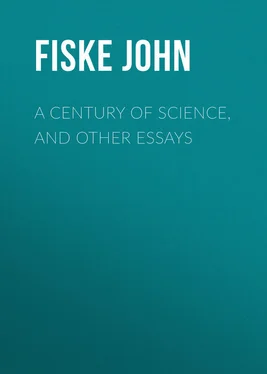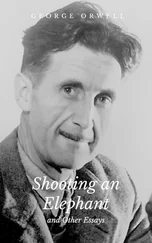John Fiske - A Century of Science, and Other Essays
Здесь есть возможность читать онлайн «John Fiske - A Century of Science, and Other Essays» — ознакомительный отрывок электронной книги совершенно бесплатно, а после прочтения отрывка купить полную версию. В некоторых случаях можно слушать аудио, скачать через торрент в формате fb2 и присутствует краткое содержание. Жанр: foreign_antique, foreign_prose, на английском языке. Описание произведения, (предисловие) а так же отзывы посетителей доступны на портале библиотеки ЛибКат.
- Название:A Century of Science, and Other Essays
- Автор:
- Жанр:
- Год:неизвестен
- ISBN:нет данных
- Рейтинг книги:3 / 5. Голосов: 1
-
Избранное:Добавить в избранное
- Отзывы:
-
Ваша оценка:
- 60
- 1
- 2
- 3
- 4
- 5
A Century of Science, and Other Essays: краткое содержание, описание и аннотация
Предлагаем к чтению аннотацию, описание, краткое содержание или предисловие (зависит от того, что написал сам автор книги «A Century of Science, and Other Essays»). Если вы не нашли необходимую информацию о книге — напишите в комментариях, мы постараемся отыскать её.
A Century of Science, and Other Essays — читать онлайн ознакомительный отрывок
Ниже представлен текст книги, разбитый по страницам. Система сохранения места последней прочитанной страницы, позволяет с удобством читать онлайн бесплатно книгу «A Century of Science, and Other Essays», без необходимости каждый раз заново искать на чём Вы остановились. Поставьте закладку, и сможете в любой момент перейти на страницу, на которой закончили чтение.
Интервал:
Закладка:
So Mr. Spencer took up Baer's problem, and carried the solution of it much further than the great Esthonian naturalist. He showed that in the development of the ovum the change from homogeneity to heterogeneity is accompanied by a change from indefiniteness to definiteness; there are segregations of similarly differentiated units resulting in the formation of definite organs. He further showed that there is a parallel and equally important change from incoherence to coherence; along with the division of labour among the units there is an organization of labour: at first, among the homogeneous units there is no subordination, – to subtract one would not alter the general aspect; but at last, among the heterogeneous organs there is such subordination and interdependence that to subtract any one is liable to undo the whole process and destroy the organism. In other words, integration is as much a feature of development as differentiation; the change is not simply from a structureless whole into parts, but it is from a structureless whole into an organized whole with a consensus of different functions, and that is what we call an organism. So while Baer said that the evolution of the chick is a change from homogeneity to heterogeneity through successive differentiations, Mr. Spencer said that the evolution of the chick is a continuous change from indefinite incoherent homogeneity to definite coherent heterogeneity through successive differentiations and integrations.
But Mr. Spencer had now done something more than describe exhaustively the evolution of an individual organism. He had got a standard of high and low degrees of organization; and the next thing in order was to apply this standard to the whole hierarchy of animals and plants according to their classified relationships and their succession in geological time. This was done with most brilliant success. From the earliest records in the rocks, the general advance in types of organization has been an advance in definiteness, coherence, and heterogeneity. The method of evolution in the life history of the animal and vegetal kingdoms has been like the method of evolution in the life history of the individual.
To go into the inorganic world with such a formula might seem rash. But as the growth of organization is essentially a particular kind of redistribution of matter and motion, and as redistribution of matter and motion is going on universally in the inorganic world, it is interesting to inquire whether, in such simple approaches toward organization as we find, there is any approach toward the characteristics of organic evolution as above described. It was easy for Mr. Spencer to show that the change from a nebula into a planetary system conforms to the definition of evolution in a way that is most striking and suggestive. But in studying the inorganic world Mr. Spencer was led to modify his formula in a way that vastly increased its scope. He came to see that the primary feature of evolution is an integration of matter and concomitant dissipation of motion. According to circumstances, this process may or not be attended with extensive internal rearrangements and development of organization. The continuous internal rearrangement implied in the development of organization is possible only where there is a medium degree of mobility among the particles, a plasticity such as is secured only by those peculiar chemical combinations which make up what we call organic matter. In the inorganic world, where there is an approach to organization there is an adumbration of the law as realized in the organic world. But in the former, what strikes us most is the concentration of the mass with the retention of but little internal mobility; in the latter, what strikes us most is the wonderful complication of the transformations wrought by the immense amount of internal mobility retained. These transformations are to us the mark, the distinguishing feature, of life.
Having thus got the nature of the differences between the organic and inorganic worlds into a series of suggestive formulas, the next thing to be done was to inquire into the applicability of the law of evolution to the higher manifestations of vital activity, – in other words, to psychical and social life. Here it was easy to point out analogies between the development of society and the development of an organism. Between a savage state of society and a civilized state, it is easy to see the contrasts in complexity of life, in division of labour, in interdependence and coherence of operations and of interests. The difference resembles that between a vertebrate animal and a worm.
Such analogies are instructive, because at the bottom of the phenomena there is a certain amount of real identity. But Mr. Spencer did not stop with analogies; he pursued his problem into much deeper regions. There is one manifest distinction between a society and an organism. In the organism, the conscious life, the psychical life, is not in the parts, but in the whole; but in a society, there is no such thing as corporate consciousness: the psychical life is all in the individual men and women. The highest development of this psychical life is the end for which the world exists. The object of social life is the highest spiritual welfare of the individual members of society. The individual human soul thus comes to be as much the centre of the Spencerian world as it was the centre of the world of mediæval theology; and the history of the evolution of conscious intelligence becomes a theme of surpassing interest.
This is the part of his subject which Mr. Spencer has handled in the most masterly manner. Nothing in the literature of psychology is more remarkable than the long-sustained analysis in which he starts with complicated acts of quantitative reasoning and resolves them into their elementary processes, and then goes on to simpler acts of judgment and perception, and then down to sensation, and so on resolving and resolving, until he gets down to the simple homogeneous psychical shocks or pulses in the manifold compounding and recompounding of which all mental action consists. Then, starting afresh from that conception of life as the continuous adjustment of inner relations within the organism to outer relations in the environment, – a conception of which he made such brilliant use in his "Principles of Biology," – he shows how the psychical life gradually becomes specialized in certain classes of adjustments or correspondences, and how the development of psychical life consists in a progressive differentiation and integration of such correspondences. Intellectual life is shown to have arisen by slow gradations, and the special interpretations of reflex action, instinct, memory, reason, emotion, and will are such as to make the "Principles of Psychology" indubitably the most suggestive book upon mental phenomena that was ever written.
Toward the end of the first edition of the "Origin of Species," published in 1859, Mr. Darwin looked forward to a distant future when the conception of gradual development might be applied to the phenomena of intelligence. But the first edition of the "Principles of Psychology," in which this was so successfully done, had already been published four years before, – in 1855, – so that Mr. Darwin in later editions was obliged to modify his statement, and confess that, instead of looking so far forward, he had better have looked about him. I remember hearing Mr. Darwin laugh merrily over this at his own expense.
This extension of the doctrine of evolution to psychical phenomena was what made it a universal doctrine, an account of the way in which the world, as we know it, has been evolved. There is no subject, great or small, that has not come to be affected by the doctrine, and, whether men realize it or not, there is no nook or corner in speculative science where they can get away from the sweep of Mr. Spencer's thought.
Читать дальшеИнтервал:
Закладка:
Похожие книги на «A Century of Science, and Other Essays»
Представляем Вашему вниманию похожие книги на «A Century of Science, and Other Essays» списком для выбора. Мы отобрали схожую по названию и смыслу литературу в надежде предоставить читателям больше вариантов отыскать новые, интересные, ещё непрочитанные произведения.
Обсуждение, отзывы о книге «A Century of Science, and Other Essays» и просто собственные мнения читателей. Оставьте ваши комментарии, напишите, что Вы думаете о произведении, его смысле или главных героях. Укажите что конкретно понравилось, а что нет, и почему Вы так считаете.












